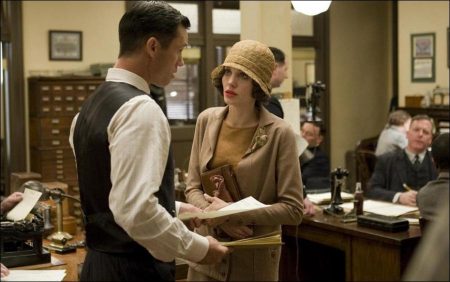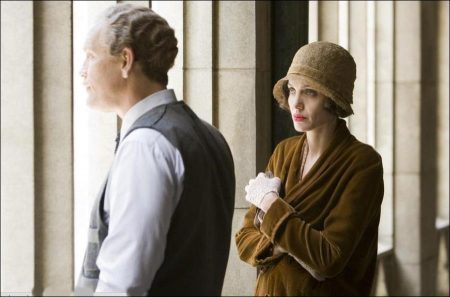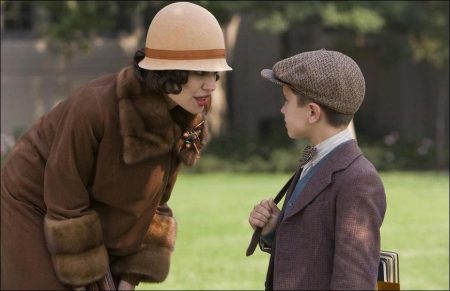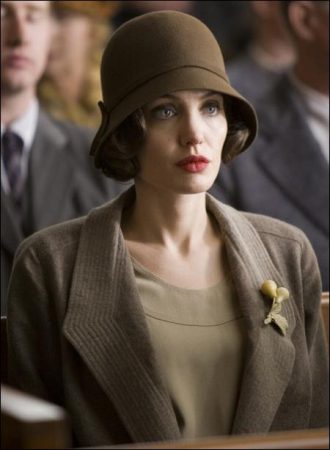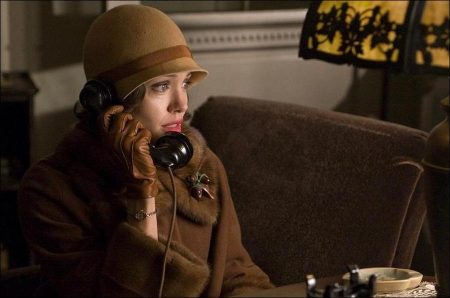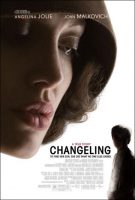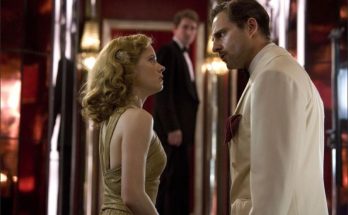Tagline: To find her son, she did what no one else dared.
Changeling movie storyline. Angelina Jolie plays a woman whose son is abducted but retrieved; she suspects, however, that the returned child is not her kid. The woman must then confront corruption in the LAPD. The story is based on true events in 1920s Los Angeles.
Clint Eastwood directs Angelina Jolie and John Malkovich in a provocative thriller based on actual events: Changeling. In the film, Christine Collins’ (Jolie) prayers are met when her kidnapped son is returned. But amidst the frenzy of the photo-op reunion, she realizes this child is not hers. Facing corrupt police and a skeptical public, she desperately hunts for answers, only to be confronted by a truth that will change her forever.
Los Angeles, 1928: On a Saturday morning in a working-class suburb, Christine said goodbye to her son, Walter, and left for work. When she came home, she discovered he had vanished. A fruitless search ensues, and months later, a boy claiming to be the nine-year-old is returned. Dazed by the swirl of cops, reporters and her conflicted emotions, Christine allows him to stay overnight. But in her heart, she knows he is not Walter.
As she pushes authorities to keep looking, she learns that in Prohibition-era L.A., women don’t challenge the system and live to tell their story. Slandered as delusional and unfit, Christine finds an ally in activist Reverend Briegleb (Malkovich), who helps her fight the city to look for her missing boy. Based on the actual incident that rocked California’s legal system, “Changeling” tells the shocking tale of a mother’s quest to find her son, and those who won’t stop until they silence her.
Legacy of a Mother’s Love: Christine Collins is Remembered
The history of Los Angeles is marked by sensational tales of corruption, cover-ups and murder during the city’s formative years. From the Roscoe “Fatty” Arbuckle rape and murder trial of young starlet Virginia Rappe in 1921 and the kidnapping of evangelist Aimee Semple McPherson in 1926 to The Black Dahlia murder in 1947, scandal has long permeated the city and shone unfavorable light upon her political operatives.
But it was the little-remembered story of one working-class woman’s struggle-amidst insurmountable odds-to find her missing son that would, almost 80 years later, forge a partnership between several of Hollywood’s most highly regarded filmmakers. The incredible tale of Christine Collins was one that almost vanished to obscurity before a former journalist stumbled upon her sensational, poignant story.
Within the subterranean halls of Los Angeles City Hall, the dusty archives of city business dating back almost 100 years are housed. Among these tens of thousands of pages of documents lies the public record of Christine Collins and the City Council welfare hearings from the late 1920s. They tell a patchwork tale of the disappearance of her nine-year-old young son, Walter, and the corrupt machinations of the Los Angeles Police Department during and after the flawed investigation of the case.
Several years ago, screenwriter J. Michael Straczynski, a former journalist who has written for Los Angeles Times, The Herald Examiner and Time, among other publications, stumbled across this astonishing story of a working-class woman who brought down a political machine. As the adage is written, a reporter is only as good as his sources, and Straczynski knew he had a lead when a longtime contact phoned him up.
Recalls the screenwriter: “A source I had at City Hall called one day and said they were burning old records and that there was something I should take a look at before they put it into the incinerator. So I zoomed down to City Hall, and they had a transcript of a City Council welfare hearing in the case of Christine Collins. I began reading the testimony and thought, `This can’t actually have happened. This has got to be a mistake.’But it was enough for me to get hooked before the book went into the fire.”
Los Angels in 1928 was in the grips of a despotic political infrastructure, led by Mayor George E. Cryer and enforced by Police Chief James E. “Two Guns” Davis (often photographed in a gunslinger pose with his weapons) and his sanctioned gun squad that terrorized the city at will. That despotic rule began to unravel when Collins, a single mother raising a son in a working-class neighborhood in Los Angeles, reported her nine-year-old missing. Months of fruitless searching followed, and the police had nothing to show, save an onslaught of negative publicity and mounting public pressure to find a solid lead in the kidnapping.
When a boy claiming to be Walter was discovered in DeKalb, Illinois, Christine Collins-and all involved in the search-waited with bated breath. Letters and photos were exchanged, and the authorities believed the missing persons case had been solved. Collins scraped together the money to bring the boy home, and LAPD organized a very public photo-op reunion with the found child and mother.
Hoping to put a stop to the scrutiny surrounding their inability to solve this case and others-and desperate for uplift from human-interest success to counter the string of corruption scandals-members of the department felt the reunion could spell public redemption for LAPD’s top brass.
The only problem was that the child who arrived home was not Walter. Despite her immediate and repeated declarations that the boy returned was not hers, Collins was rebuffed by the officer in charge of her case, Captain J.J. Jones. She was told-as recounted from the City Council hearing transcripts of the day-to “try him out for a couple of weeks.” Confused and disoriented, she agreed. Case closed.
Until three weeks later, when Collins brought “Walter” back, insisting that, no matter what anyone said, this child wasn’t hers. Unaccustomed to having their actions questioned by anyone, let alone a woman, Captain Jones-with the tacit approval of Chief Davis-subjected Collins to slander and committed her to the County psychopathic ward as a patient, instead of admitting the mistake of returning the wrong boy. Collins would be forced to spend five harrowing days in the psychiatric ward, housed against her will due to a “Code 12”-a term that referred to a difficult or inconvenient person, usually a woman, jailed or committed to the local psychopathic ward without a warrant or any legal due process.
The child who reappeared as Walter later admitted to being 12-year-old Arthur Hutchens (who also used the alias Billy Fields), a Midwest runaway who wanted to come to Hollywood in hopes of meeting his favorite film actor, Tom Mix. At a roadside café in Illinois, a diner remarked that he had an astonishing resemblance to the kidnapped Collins boy of Los Angeles. Hutchens hatched a plot to turn himself in to local authorities as the missing Walter, have Christine Collins pay for his bus fare to Los Angeles and provide room and board. His actions unknowingly set off a chain of events that would forever alter the policing of Los Angeles’ residents.
For Straczynski what was, at first glance, astonishing became increasingly compelling the more he dug into the details of the case. He researched the story for approximately a year, digging through the intricate details of Collins’ seven-year journey to find answers surrounding her son’s disappearance. What he found was even more disturbing than Hutchens’ hoax. Underneath the dusty files emerged a parallel case-one that told the depraved details of child predator Gordon Northcott (alternately admitting and then denying the killing of the still missing Walter Collins) and the unyielding power and violence of the Los Angeles authorities of the period.
The screenwriter also discovered a man named Gustav A. Briegleb, a Presbyterian minister who assisted Collins in her search for answers. A longtime thorn in the side of the establishment, the community activist was a voice of authority whose radio show and powerful sermons challenged listeners not to turn a blind-eye to police corruption. Briegleb worked with Collins and her attorney to ensure that Walter’s story was not buried and Collins’ inhuman treatment in the mental ward was revealed to all who would listen. Their work led to the dismissal of senior civic leaders and exposed corruption that was commonplace in the day.
Although Collins died in 1935 not knowing what happened to her son, Straczynski sums up just how powerful her legacy was: “The core of it all is Christine Collins’ desire to find out what happened, and never giving up, no matter what anyone threw at her. She never abandoned the quest to find out what happened to her son. That tenacity carried her through things that would break anybody else, but she never once stopped fighting. That reverberated throughout the state’s legal system, and I wanted to pay tribute.”
Straczynski admits of drafting his script: “My intention was very simple: to honor what Christine Collins did. My job was to tell the story as honestly as I could and honor the fight she waged and how she never once lost faith and kept looking for her son. Her simple question: `Where is my son?’ brought down the entire L.A. city structure.” To add to the veracity of his story, the writer would pull quotes verbatim from the files…along with other direct testimony he incorporated into the film’s script.
Screenplay finished, Straczynski would begin the search for filmmakers and a Christine Collins who could honor the story of not only this pioneer in victim’s rights, but a champion of the people. He would find that in Clint Eastwood, Imagine Entertainment and Angelina Jolie. It was a proud moment for Straczynski, whose previous script work had been predominantly in the genre of television science fiction. L’Échange would be his first produced feature film.
Eastwood, Imagine and Jolie Team: L’Échange is Greenlit
The shocking “based on actual events” story caught the attention of Academy Award-winning producers Brian Grazer and Ron Howard, who have excelled at bringing real-life stories to the big screen-notably with such critical and box-office successes as American Gangster, A Beautiful Mind, Cinderella Man, Friday Night Lights and Apollo 13.
“There is an excitement for me when drawing from a true story,” remarks Grazer. “I liked the subject matter of L’Échange, found the culture surrounding this incident to be fascinating, and in some ways appalling, but it captivated me. The fact that it did happen gives this story so much more emotional gravity.”
Knowing director/producer Clint Eastwood had a similar sensibility when it came to fact-based material, Grazer and Howard called the filmmaker to discuss the script they had optioned. “I took it with me on a trip to Berlin,” recalls Eastwood. “On the way back on the plane, I read it and I liked it a lot. As soon as I got in, I called Brian and Ron and said, `Yeah, I’ll do this.’ And they said,`Angelina Jolie liked the script and wants to do this.’ I said, `She’d be great. I like her work a lot.’ And that’s how it came about-very quick and simple.”
Eastwood’s longtime production partner, Rob Lorenz, was just as awestruck as others who had read Straczynski’s tale. “I was about 15 pages into the script, and I had to flip back to see if it was really a true story; it was just so amazing to me,” Lorenz remarks. “Joe [Straczynski] had done something very clever. He stuck photocopies of news clippings every 15 or 20 pages in the script, just to remind you it was true. I was not only amazed it was all true, but astonished that I had never heard of the story before and nobody seemed familiar with it.”
With their interest piqued for a script in which Eastwood found the “truth was stranger than fiction,” Eastwood and Lorenz agreed with the Imagine Entertainment team that the unbelievable events would make a captivating film, as long as Academy Award winner Angelina Jolie took the role as the working-class single mother who made it her life’s mission to find her boy. Of his Christine Collins, Eastwood remarks, “Angelina is unique. She reminds me a lot of the actresses from the Golden Age of movies in the ’40s-Katharine Hepburn, Ingrid Bergman, Bette Davis, Susan Hayward, all of them. They were all very distinctive, and they all had a lot of presence. She’s a tremendous actress.”
Howard and Grazer were pleased with the outcome on all fronts. Notes Grazer, “I bought L’Échange’s script and, like everybody does, created a list of the top directors in the world. You start with your dream and you work your way down. I started with a dream and got it with Clint Eastwood, and then to have Angelina Jolie step into this role was very exciting. She is just perfect for it. She’s so emotionally available, alert and present.”
Despite a riveting story and the high caliber filmmaking team, Jolie was initially reluctant to tackle the role of a mother whose son is kidnapped. Understandably so, as she had recently finished a heartbreaking portrayal of Mariane Pearl in A Mighty Heart, the true story of the kidnapping and execution of journalist Daniel Pearl. However, she was willing to explore options and read the screenplay. Straczynski’s interpretation of Christine’s tale changed her mind.
“It’s an extraordinary story,” Jolie reflects. “I couldn’t stop reading it. When she faced a setback and would get back up, I’d think, `Good, you’re back up.’ Christine Collins is a woman whom I came to admire but, as an actor, there was a lot about the story I didn’t want to do. I didn’t want to do a film about a child being kidnapped, because I think there’s something to bringing certain things into your environment, in your thoughts and in your world. But ultimately, it was her strength when faced with such odds that swayed me. I’m most fond of this story because of how it exposes corruption of those in power. It’s very timely; we still deal with that today.”
With the director, producers and lead actor in place, Eastwood and the other filmmakers began their search for the other players in Christine Collins’ late 1920s and early ’30s world-the men and women who would shape the story of L’Échange.
Cops, Preachers and Serial Killers
As Christine Collins navigated her way through landmines of wavering public opinion, disbelieving police and shadowy gun squads to find her son, she was joined by a group of supporters and detractors. From activist Reverend Gustav Briegleb, the pastor of St. Paul’s and Westlake Presbyterian churches in Los Angeles, and attorney S.S. Hahn, a defense attorney known for high profile criminal cases, to Police Captain J.J. Jones, the stalwart adversary who would continue to be a presence throughout Collins’ seven-year quest for answers, the screenwriter kept the actual names of players in Collins’ world whenever possible. L’Échange would also allow for characters that were an amalgam of people and types who lived in L.A. of the day.
Reverend Briegleb was considered a fearless activist who positioned himself as a watchdog against the unbridled corruption in city government, and even the film industry. Briegleb was quick to point out that fellow Los Angelenos were too easily buying the stories of police who claimed their dodgy actions were beneficial; he preached that citizens should look closer at the truth and ferret out the corruption. Portrayed by accomplished actor John Malkovich, the reverend’s insider knowledge of the city’s political machine played a pivotal role in Collins’ search and, ultimately (in our story), saved her life.
Of the impact Reverend Briegleb had on Christine Collins, Jolie explains that the two had a “wonderful friendship.” She offers, “He’s quite a voice at the time, and he really draws her to him and helps guide and teach her. He gives Christine this sense of strength, which can only come from somebody of a different kind of authority. The reverend says,`You are not crazy, and these are not good people; even if they’re in authority, that doesn’t mean you should give them that respect. You should question them.’ He helps her to find her own voice.”
Eastwood previously worked with Malkovich on the drama In the Line of Fire and was keen to again partner with the film and stage performer. “I’ve liked John’s acting for a long time,” says the director. “I thought that he would be an interesting casting choice for the role. John brings a little edge, a little quirkiness to the table; he’s a chameleon.”
Malkovich was curious to tackle the part of this early crusader for justice. Of Briegleb’s activism, he offers, “It’s probably a fairly early example of the kind of pressure that can be brought to bear by the media. Briegleb had his radio show; he did his radio address and read his sermons. He really put a spotlight on the LAPD and on what he perceived to be their horrendous practices.”
Reverend Briegleb saw the 1920s LAPD as the most incompetent, violent and corrupt police force “this side of the Rocky Mountains.” Malkovich viewed his character as a man who rallied for justice, even when it was unpopular and dangerous. The performer admits he found it, “amazing to think…as my character quotes of Police Chief Davis: `We will hold trial on gunmen in the streets of Los Angeles. I want them brought in dead, not alive, and I will reprimand any officer who shows the least bit of mercy to a criminal.’” That kind of pressure on Davis’ officers could explain their interest in quickly solving the Walter Collins case…and ignoring the fact that the wrong boy had been returned to the right mother.
Legendary attorney S.S. Hahn, played by character actor GEOFF PIERSON, took on the Collins case and sewed the seeds for future legislation that would eventually overturn “Code 12” incarcerations. As the scion of the prominent Los Angeles family, his political legacy spanned decades…and includes future generations of politicians from former L.A. County Supervisor Kenneth Hahn to its recent mayor, James Hahn.
Actor Jeffrey Donovan was cast as the merciless, by-the-book police Captain J.J. Jones, the head of LAPD’s juvenile division who bullies the traumatized Collins into accepting the young boy as hers. Although Collins filed a civil suit against the city and Jones and won $10,800, she never recovered any of the monetary judgment against him. That would not keep the crusader from coming back every couple of years to try and reclaim the damages to fund the search for her still-missing boy.
Donovan was fascinated by the fact that not only was his character based on an actual person, but also by the amount of power Captain Jones wielded. The actor notes, “It’s unfathomable what he did to this woman. I talked to Angelina about the scenes when I’m committing her to the insane asylum; what I’m saying is actually in public record. I couldn’t believe that another human being-without warrant and without regard of any facts-could actually commit someone with such a quick snap of his fingers.”
Even as the Walter Collins case remained unsolved, a stunning revelation from a parallel investigation would come to light for local law enforcement. The twisted story of a charismatic child predator named Gordon Stewart Northcott would set the stage for years of a psychological cat-and-mouse game between Northcott and Christine Collins.
In 1928, Gordon Northcott’s (Jason Butler Harner) 15-year-old nephew, Sanford Clark (EDDIE ALDERSON), led police to a grisly discovery at his uncle’s chicken ranch near Wineville, California (located near Riverside and today known as Mira Loma). There the officers, led by Detective Lester Ybarra (Michael Kelly), uncovered the remains of children killed with an axe and buried nearby. Sanford swore that young Walter was one of those killed, but the truth is still unclear today.
The subsequent investigation uncovered the grisly life of the Northcott “murder farm” and partially solved the mysterious disappearances of some of the dozens of young boys who had vanished in the region. It was found that 24-year-old Northcott, along with his mother, Sarah Louise Northcott, had kidnapped, tortured and killed young boys on their land. The serial killer was ultimately convicted and executed for the slaying of four boys, though the number is estimated to be much higher. A narcissistic publicity hound, Gordon Northcott-until the day he was executed by the state of California-used contradicting statements to toy with Christine Collins about the fate of Walter. Northcott’s conspiratorial mother was given a life sentence at San Quentin Prison.
When casting Northcott, Eastwood was shocked by a similarity in look between the infamous murderer and performer Jason Butler Harner. The director comments: “Ironically, he has a certain resemblance to our serial killer. He has a certain look, and when he was fixed up, he looked very much like Northcott. Jason’s a terrific actor.”
Though difficult for any performer to thoroughly embody a sociopath, Harner was moved by the twisted game Northcott played with Christine Collins. Notes the actor, “From the moment Gordon meets her in the courtroom, the first time he sees her, he plays cat and mouse with her. The minute he sees and recognizes her, he assumes a familiarity, because she’s in the headlines…as he is in the headlines. Therefore, in his eyes, they’re kindred spirits.”
The filmmakers sought to build the supporting roles through a mix of stage and character actors from New York and Los Angeles. Stage and screen performer DENIS O’HARE, who recently co-starred opposite Jolie in A Mighty Heart, was cast as Dr. Jonathan Steel, a psychiatrist who brutally rules the County mental ward in which Christine is forcibly placed under a “Code 12.” O’Hare explains that term “was a catchall excuse to punish anyone who dissented, protested, caused trouble or objected to police methods. I think the net was pretty wide, and it tended to punish women.”
One of Steel’s unwilling patients was Carol Dexter, a prostitute who had a relationship with a police officer that went awry. Dexter, now forced to endure subhuman treatment at the hands of the mental ward’s staff, becomes an unlikely savoir to Collins after the grieving mother’s incarceration. The detainee enlightens the terrified Collins on the realities of their incarceration, and attempts to spare Christine the indignities to which she’s been subjected. To play the “soiled dove,” (a term of the era for ladies of the night), Academy Award-nominated actress Amy Ryan was cast.
Fresh off her lauded performance in Gone Baby Gone, the actor was eager to visit another era of American history and play a wrongfully accused character. Notes Ryan: “Carol says to Christine,`If we’re crazy, meaning women, nobody has to listen to us.’ If a woman had an opinion or went against any voice of authority, she must have been crazy. Therefore, the attitude was `lock them up!’”
Angelina Jolie comments that when she last played a character in a mental institution (and won an Oscar for her performance as escape artist Lisa Rowe in 1999’s Girl, Interrupted), her role was similar to her savior in L’Échange. Jolie reflects, “Last time I was in a mental institution for a film, I was certainly more Amy’s character. I was the more aggressive, kind of fun one.”
To further drive the story, the filmmakers fleshed out the real-life individuals of Christine Collins’ era by creating several merged characters. Remarks producer Lorenz, “Joe did an excellent job of putting all the facts in order and then crafting these composite characters that we fit into the story so they could move it along. It’s amazing that it comes together so neatly as a story and, yet, it is still rooted in truth.” These characters include Lester Ybarra, the LAPD detective who would break the Northcott case and establish a possible link with the Walter Collins case after local law enforcement are tipped off by Northcott’s nephew, Sanford Clark. Additionally, the life and back-story of Police Chief James E. Davis (portrayed by Colm Feore), a man who was quite eager to have Christine Collins disappear, was reimagined by the screenwriter/historian.
Last but not least, young performer Gattlin Griffith was cast to play the nine-year-old Walter Collins and actor Devon Conti appears as his doppelganger, Arthur Hutchens, the manipulative 12-year-old who simply wants to escape life in the Midwest. Cast in place, the director and producers would go about the arduous task of imagining the world of Los Angeles as it existed almost 80 years earlier.
Re-creating 1920s L.A.: Locations and Design
With more than 30 films to his directorial credit, Eastwood has mastered the economy of shooting and considers himself a director influenced by choices he would make as an actor. He limits rehearsals to achieve a more authentic feel in the performances and is not a fan of endless takes, a fact about which the cast of L’Échange was appreciative. “Everything I do as a director is based upon what I prefer as an actor,” Eastwood says. “It’s all a learning process over the years. No matter how you plan it, things happen that either work for you or against you. So there’s always the excitement of trying to make it work, of taking a little stack of paper and make it into a living thing.”
It’s a factor his team embraced during production. “Clint’s extraordinary,” cites Jolie, “I can’t say enough about him. I could go on forever. As a director, he’s so decisive. He’s got that leadership quality of a great man who values every single person on the film, and so they bring their best, and it’s appreciated. He takes the time to consider things. He’s just brilliant. I don’t think I want to do any other films without him.”
Locations
In L’Échange, the bustling City of Los Angeles serves as the backdrop of the Collins story as it plays out from Walter’s disappearance to Christine’s fight against the system. From the initial images of a happy family in a modest suburban home and the bustling phone operators’ bank where Christine whizzes the workday away on roller skates to staging hundreds of demonstrators marching on City Hall after they’re made aware of Christine’s treatment, L’Échange would crisscross Southern California.
An extensive amount of research was necessary to duplicate specific locations and images of the late 1920s and early ’30s. Initial location scouts revealed that older buildings had been torn down, streets replaced by super highways and complete neighborhoods razed-including the one where the Collins family lived (east of Chinatown in contemporary L.A.). That area is now unrecognizable if one compares photos from today with those taken 80 years ago.
The filmmakers looked to production designer James Murakami and location manager Patrick Mignano to visualize the period in modern day Los Angeles. Murakami previously worked with Eastwood and DP Stern on Letters from Iwo Jima, so he was familiar with the director’s aesthetic and the cinematographer’s style.
It was a challenging task, but Murakami and his team were able to discover untapped suburban locales in San Dimas, San Bernadino and Pasadena, among other sites to stand in for ’20s-era L.A. The art department-complementing the location shoots in the above locales, Los Angeles City Hall and sets that were built on the Universal Studios backlot-supplemented key scenes. Naturally, visual effects supervisor Michael Owens would be called in to add effects enhancements and re-create backdrops such as the city skyline and the red streetcars that then populated the region.
Perhaps the biggest twist of kismet came with the discovery of a neighborhood in the Olde Town district of suburban San Dimas, located approximately 35 miles east of Los Angeles. A tree-lined block of homes provided a remarkably close facsimile of what Murakami needed for the interior and exterior of the 1920s Collins home, as well as the surrounding neighborhood.
“We were very fortunate to find the location in San Dimas,” remembers Murakami. “Very little had changed in that section of town, and after seeing some of the footage we shot…it was just beautiful. Overall, we kept it as simple as possible. The colors are subdued to make it comfortable. Our set decorating department fully fleshed out every set and location with a great attention to detail.”
In Los Angeles, the streetcar service, with the iconic red streetcars that crisscrossed from the City of Pasadena to the beaches of Santa Monica, was an aspect of the region’s rich history vital for inclusion in the story. Helpfully, the film’s red streetcar was equipped with an engine, so it could be driven on the streets of Pasadena and Los Angeles during the shoot.
Recalls Eastwood of Los Angeles’ changing landscape over the years, “I have the advantage because I’m senior to Rob and the others,” he laughs. “So, I remember a lot of those things growing up. When I first came to L.A. in the ’50s, it was quite a bit different. Even then, the red streetcars were everywhere. They were very popular at the time.”
Filming just outside the city limits of Lancaster, situated 75 miles north of Los Angeles, the production used a small farm to substitute for Northcott’s haunting chicken ranch. To inform their design, Murakami and team traveled to the original farm where the killings took place. “It was eerie to be there,” recalls the production designer, but it was necessary for the crew to understand the topography and layout. Using news photos from the period, they re-created the entire farm.
Current construction on Los Angeles City Hall was completed in 1928, but small details had to be considered when returning to the site for filming. The building on Spring Street today, surrounded by new architecture and parking lots, has shown its weathering over the decades. Once again, Owens’ effects team would step in to paint the world of 80 years ago.
Curiously, the past and present meshed as cast and crew filmed on the steps of City Hall. Actors Colm Feore and Reed Birney (as Chief Davis and Mayor Cryer) were filming a scene just feet away from the building’s dedication inscription-which identifies the honorable George E. Cryer as the city’s mayor. It was a surreal moment for actors cognizant of the historical figures they were portraying.
Clothing
After working on back-to-back period Eastwood films set in the 1940s (Flags of Our Father and Letters from Iwo Jima), Deborah Hopper knew of every major vintage clothing house from Los Angeles to Canada. She would employ all her contacts to find a range of clothing, undergarments and shoes for the close to 1,000 men, women and children that peopled the production. Additional research was necessary, however, to accurately depict the quantity of Depression-era clothing needed for the background actors.
From sharp wool suits for the police officers to knickers and long socks for the two Walters, “It’s always a challenge to try to find vintage clothes,” provides Hopper. “Especially with the earlier periods, because these fabrics simply don’t last; they fall apart. So we went everywhere around this country and then some.” She laughs, “We did come up with enough clothes, but barely.”
From working-class women to society matrons of the day, the late 1920s style included a demure silhouette of dropped-waist dresses, substantial fur-trimmed coats and cloche hats (to set off close bobs and finger-waved hair), pulled down low and worn with hand-knitted gloves. The decorum of the period was more formal; even the most casual looks appear quite conservative by today’s standards.
Luckily, once Hopper began to research archival footage on Christine Collins, she was able to compile enough information to pull together an accurate and complementary design palette for Angelina Jolie. The costume designer’s attention to detail and collaborative design aesthetic proved to be an integral part of Jolie’s approach to the character. “The wardrobe choices are really the first steps toward Christine,” Jolie comments. “There is something about the style of clothes of the ’20s that is very sweet. They make you feel a little softer and just so delicate, hidden behind it all. It helped me very much.”
One unexpected wardrobe item needed for several of Jolie’s scenes as a supervisor at the telephone company in which Collins oversees a staff of operators was a pair of leather-strapped roller skates…over heels. Jolie would have to learn-thanks in part to photos from the period that documented the practice-to stride up and down the film set in this unique transportation device.
“Roller skating in heels for a role is one of the funniest things I’ve done in my career,” laughs the actor. “It’s great that it’s in the story, though, because it’s an example of the nutty things that people did in the ’20s.”
The production had a powerful effect on all the cast and crew, especially Jolie and her interest in celebrating what any parent would do to take care of his or her child. The actor concludes of a shared experience that bonded her with L’Échange’s cast and crew: “In films that call for really deep acting, you really cry together, you get angry together and you really pull through. Then you have this little journey, and it does bond you as human beings. You bond through your emotions and through your experiences, so I think it does make for fast friendships.”
Eastwood closes with a quote paraphrased from Jimmy Cagney, but it might as well have been said by Christine Collins herself. When pressed by detractors, one thing we can all do is “Plant your feet and tell the truth.”
If Walter Collins is alive today, he is 89 years old.
Changeling (2008)
Directed by: Clint Eastwood
Starring: Angelina Jolie, Jeffrey Donovan, Colm Feore, John Malkovich, Amy Ryan, Michael Kelly, Michelle Gunn, Jason Butler Harner, Kerri Randles, Morgan Eastwood
Screenplay by: J. Michael Straczynski
Production Design by: James J. Murakami
Cinematography by: Tom Stern
Film Editing by: Joel Cox, Gary Roach
Costume Design by: Deborah Hopper
Art Direction by: Patrick M. Sullivan
Music by: Clint Eastwood
MPAA Rating: R for violent and disturbing content, and language.
Distributed by: Universal Pictures
Release Date: October 24, 2008
Views: 96
